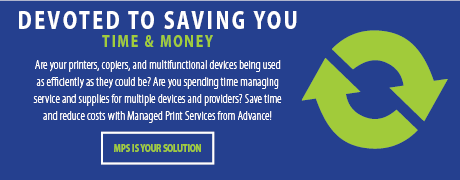Blog
The Stuff
Advance Your Company’s Print Strategy
Posted On November 28, 2011 By Scott Guercio
I recently joined a colleague of mine, here at Advance, on an appointment to meet with a potential new client. We were granted this opportunity based on the success of a solution that we had implemented in one of their affiliate organizations. This first meeting was our initial discovery conversation. It was a chance for us to better understand the current critical business issues that our products and services could help them solve. While many of our capabilities today focus on electronic document workflow, this particular situation revolved around developing a strategy for managing print output.
Learn how to reduce your company’s print costs by up to 30% by clicking here.
Like many organizations, this company has had no structure in place for the acquisition and support of their numerous multifunctional copiers and desktop printers. Each department was allowed to make its own buying decisions. The result was a list of as many devices as there were employees, and no two machines were the same. The vast majority of the machines were purchased from retail super-stores because of the fairly low equipment cost (however, with these types of devices, the operational expenses are very high). By using our Advance software tool called DocuLife Line, we were able to “ping” the network to discover all of the company’s network connected printers, and it pulled the current meter counts. Along with this report, we performed a physical walkthrough to find the fax machines, stand alone copiers and locally connected printers. This allowed us to document every machine and its location by user and department.
With the data that we collected, and with the help of the client, by gathering their current lease costs and the last year of ink supply spending, we were able to quantify the organization’s approximate expenses. This process can be very eye opening for a company that has frankly not been paying attention to the cost of their print output, and these costs are just taking into account the equipment and consumed supply expenses. They are not taking into account the time spent by the IT department setting up, configuring, troubleshooting and maintaining a large number of printers and print drivers, nor do they take into account the hundreds and hundreds of dollars in unused supplies. Companies also forget to account for the administrative burden associated with all of the printer related transactions with different vendors.
Our plan for this organization was a print strategy based on consolidation and consistency, to be managed by a centralized group of administrators. This would make their company more efficient, while significantly reducing their expenses. The equipment would be a mixture of multi-functional digital copiers and network laser printers. However, the number of devices would be less than they were previously using. Where it made sense, local printers would be removed, with their output now being directed to more productive and cost effective workgroup devices. We would standardize on one model of a multi-functional copier and one model of a laser printer. This would make supply ordering and stocking very easy, end users would have the comfort to use any of the company’s machines, and the IT staff would not have to maintain numerous different print drivers, as they had in the past. Also, the IT department would no longer have to interrupt their normal activities to troubleshoot printer issues, as that would now be handled by Advance. For the accounting team, what were many different monthly invoices would now be consolidated into one. All of this would be possible for less than they were spending on their current mixture of output devices.
If this scenario sounds like your business, give Advance a call. Our professionals will help you better understand your current print environment while helping you develop a strategy to drive your output to the most cost effective devices. They will plan for the consolidation and removal of your most expensive devices and can even help you shift your print output to an electronic workflow. A proper print strategy will create greater efficiencies for your organization by allowing IT and Administrative staff more time to focus on their core activities, and it will reduce the expenses related to critical information workflow.
